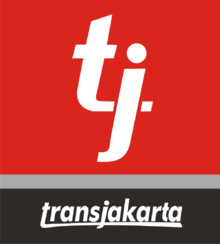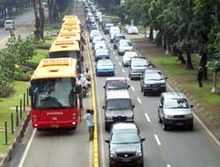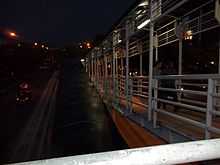TransJakarta
| TransJakarta | |||
|---|---|---|---|
 | |||
| Background | |||
| Locale | Jakarta, Indonesia | ||
| Transit type | bus rapid transit | ||
| Number of lines | 12 (operation), 3 (planned) | ||
| Number of stations | more than 200 | ||
| Daily ridership | more than 350,000 | ||
| Website | |||
| Operation | |||
| Began operation | January 25, 2004 | ||
| Operator(s) | Badan Layanan Umum TransJakarta Busway | ||
| Technical | |||
| System length | around 200km | ||
| |||
TransJakarta is a bus rapid transit (BRT) system in Jakarta, Indonesia. It was the first BRT system in Southern and Southeast Asia. The TransJakarta system began operations on January 25, 2004. As of February 14, 2013 the 12th corridor was added officially, with 3 more currently corridors in progress. TransJakarta was designed to provide Jakarta citizens with a fast public transportation system to help reduce rush hour traffic. The buses run in special lanes and ticket prices are subsidized by the regional government. In 2011 TransJakarta carried around 115 million passengers (about 310,000 passengers per day) which was an increase of 32% the 87 million passengers carried during 2010. The subsidy per passenger-ticket in 2011 was around Rp 2,900 ($0.29) and for 2012 the subsidy is expected be around Rp 2,100 ($0.21) per passenger-ticket.[1] Currently TransJakarta has the world's longest BRT routes (172 km in length) and has more than 669 buses in operation.
Characteristics
The characteristics of TransJakarta as listed in an Asian Development Bank study were:[2]
- Closed Trunk System without a Feeder System
- Elevated Platform for Rapid Boarding and Alighting
- Public Sector Bus Procurement and Private Sector Bus Operation
- Operating at 65,000 passengers/day (higher than projected) (2004)
History and Problems

The first TransJakarta line opened to the public on January 15, 2004. Following two weeks in which it was free to use, commercial operations started on February 1, 2004. It now carries an average of approximately 250,000 passengers a day.[3]
TransJakarta was built to provide a fast, comfortable, and affordable mass transportation system. To accomplish those objectives, the buses were given lanes restricted to other traffic and separated by concrete blocks on the streets that became part of the busway routes.
There were some initial teething problems, such as when the roof of one of the buses rammed into a railway tunnel. In addition, many buses had technical issues such as broken doors and stop buttons.
In order to promote gender equity, TransJakarta is increasing the number of female driver recruits. The projected proportion is 30% of the total.
The buses run along the following routes:
- January 15, 2004: Koridor 1, Blok M to Kota (soft launch)
- February 1, 2004: Koridor 1, Blok M to Kota (commercial service)
- January 15, 2006: Koridor 2 (Pulo Gadung to Harmoni) and Koridor 3 (Kalideres to Pasar Baru) opened
- January 27, 2007: Koridor 4, (Pulo Gadung to Dukuh Atas 2), Koridor 5 (Kp. Melayu to Ancol), Koridor 6 (Halimun to Ragunan) and Koridor 7 (Kampung Rambutan to Kampung Melayu) opened
- February 21, 2009: Koridor 8 (Lebak Bulus to Harmoni) opened
- December 31, 2010: Koridor 9, (Pluit to Pinang Ranti) and Koridor 10 (PGC Cililitan to Tanjung Priok) opened.
- March 18, 2011 Koridor 9 was the solely corridor served until 11.00 pm. Followed by Koridor 1, with intersection with Corridor-9 at Semanggi shelter, but not all of shelters serve in this program.[4][5]
- May 20, 2011 Corridor-2 and Corridor-3 initialized to serve until 11.00pm, but only open 9 shelters out of 22 on Corridor-2 and 9 out of 13 shelters on Corridor-3 remain open during the extended hours.[6]
- July 1, 2011 Corridors-4 to 7 have already began with the late night service, so all corridors now has already deployed late night service, except Corridor-8.[7]
- September 28, 2011 the feeders have been launched with Route 1 from West Jakarta Municipal Office to Daan Mogot, Route 2 from Tanah Abang to Medan Merdeka Selatan and Route 3 from SCBD to Senayan. The fare will be Rp.6,500 ($0.72), which cover tickets for both the feeder service and TransJakarta buses.[8]
- December 13, 2011: Transjakarta began separate male and female passengers, as is done by pt kai commuter jabodetabek. The woman-only areas located between middle door and driver cabins.
- December 28, 2011: Corridor 11th Kp. Melayu-Pulo Gebang opened
- February 14, 2013: Corridor 12th Pluit - Tanjung Priok is officially opened
Accidents and incidents
From January to July 2010 there were 237 accidents involving TransJakarta buses, resulting in 57 injuries and eight deaths. Accidents occurred due to pedestrians crossing the busway and cars making u-turns. In 2011, in an effort to stop non TransJakarta vehicles using the bus lanes, the Jakarta Police Chief suggested that TransJakarta buses should run against the direction of traffic flow.[9] Usually non TransJakarta vehicles used busway lanes during peak hours between 6 a.m. to 9 a.m. and 4 p.m. to 7 p.m.[10]
On January 12, 2012 a policeman from Indonesian Police Headquarters, who is hired by Securicor, fired his gun near the ear of a TransJakarta officer, after threatening to kill him. The policeman was angry after the TransJakarta officer stopped the Securicor car from entering the busway lane which only allows TransJakarta buses, ambulances and firefighter to enter. The police spokesman said that the policeman will be charged by criminal law or disciplinary sanction.[11][12][13]
Hijack
On March 12, 2012 four TransJakarta buses were hijacked by alleged university students at the Medan Merdeka Selatan street. The buses were then driven to the front of the Universitas Kristen Indonesia (Christian University of Indonesia) campus. Three drivers were able to escape from their buses, but one driver was prevented from leaving and forced to drive the hijackers to their destination. Bus' fire extinguishers, glass-breaking hammers and driver's jackets were also taken.[14]
Buses
Each bus is constructed with passengers' safety in mind. For example the body frame is constructed using Galvanyl (Zn - Fe Alloy), a strong and rust-resistant metal. There are also eight or ten glass-shattering hammers mounted on some of the window frames, and three emergency doors for fast evacuation during an emergency. There are also two fire extinguisher at the front and back of the buses.
The Mercedes-Benz OH and Hino RG air-conditioned buses are painted red and yellow, with a picture of a young Brahminy Kite, which looks very similar to a bald eagle grasping a tree branch with three snakefruit on it. The buses use special fuel which is (a mix of diesel and biodiesel). For Corridor 2 (bus colors: blue and white) and 3 (bus colors: yellow and red), the buses are CNG-fueled Daewoo buses imported from South Korea. Due to various coachbuilders being involved and design tweaks applied over time, the exterior and interior appearance, quality, and comfort varies between busses operating in the same corridor.
The capacity of each bus is 30 seated and 55 standing passengers, though during rush hours these numbers are often exceeded by up to 80 passengers per bus.
TransJakarta also operates Chinese-made Huanghai, Zhongtong, Ankai, local-made Komodo and Inobus articulated buses on long and straight corridors, such as Corridor 5.[15]
The passenger doors are higher than on normal buses so that passengers can only board from designated shelters. The doors employ automated folding mechanisms which can be manually controlled by the driver. Because the normal folding doors cannot open properly when the bus is overcrowded, buses on corridors II and III use sliding doors in order to accommodate the surge of passengers during rush hours. Protective full-height acrylic glass barriers are installed behind passenger seats close to the sliding door mechanism.
Seats in all buses face the aisle to optimize passengers' movement during rush hours. Corridor 1 buses use comfortable cushioned bus seats, the buses from subsequent corridors have less cushioned, hence less comfortable, seats.
Each bus is equipped with an electronic board and speakers that announce the name of shelters in two languages, Indonesian and English. Each bus is also equipped with a bi-directional radio transceiver to allow the driver to provide and recaive updated information regarding traffic jams, road accidents or lost items.
To keep the air fresh, especially during rush hours each bus is equipped with automatic air freshener dispensers which periodically spray car fragrance.
In August 2011, TransJakarta operator has installed cameras on one bus for a trial period. The plan is to install 4 cameras on all buses gradually in efforts to improve services such as to inform passengers waiting for buses about how crowded approaching buses are and prevent sexual harassment on its service.[16]
As of November 2011 TransJakarta has 524 buses in operation.
Shelters

TransJakarta shelters are different from ordinary bus stops. They are usually located in the middle of the road and are reached by elevated bridges. The stop in front of the well-known Sarinah shopping center on Jl Thamrin in Central Jakarta has elevators.
The shelters are made of from aluminum, steel, and glass. Air ventilation works through fins on the aluminum part of the shelters. Floors are made from tread plate. The doors of shelters open automatically when a bus arrives. Some of the connecting elevated bridge ramps have gentle slopes (with some exceptions) to accommodate the disabled. One disadvantage of some of the ramps is that passengers need to walk a relatively long way up the ramps and then double back to reach the boarding shelters. The floors of the bridge are mostly tread plates although some are made from concrete. One problem with the tread plate is that considerable noise is generated by the movement of passengers across the tread plate surfaces. Another problem is that some of the tread plate surfaces can become very slippery during the rainy season. There are no sanitary facilities in most of the shelters.
Bus stops are open from 05:00 – 22:00 although opening hours can be extended if there are passengers still waiting at closing time. Shelters often become extremely overcrowded because of long and sometimes unpredictable intervals between buses. According to a report from the Indonesian Consumers Protection Foundation in 2011, the most common complaint from passengers about the service offered by Transjakarta was the lengthy waiting time for buses at some of the main shelters.[17]
A free daily internal bulletin, 'Trans Kota', is occasionally available at selected shelters. The content includes sport, showbusiness, crime, health, various tips and tricks, consumer information and TransJakarta news.
The large Harmoni Central Busway (HCB) shelter on Jalan Gadjah Mada, Central Jakarta, is built over the Ciliwung River. It is a transit point between Corridors 1, 2, and 3. This 500-person shelter has six doors. Although many trees had to be sacrificed during the construction of it, an old banyan tree was not chopped down because it was considered rich in historical value. However, in October 2006 this tree was vandalized by people from the Pemuda Persatuan Islam religious group. Their motive was to show that the tree does not possess supernatural qualities.
Ticketing and Fares

The cost of a TransJakarta ticket since initial up to January 2014 is still Rp. 3,500 (about US 30 cents) per trip, or Rp 2,000 ($0.22) at concessional times (05.00a.m. to 07.00a.m.). Passengers who change direction or who transit to another corridor do not need to pay again provided they do not exit the shelter, except at end of the routes.
Passengers first buy a single trip paper ticket. To enter a shelter, passengers show their tickets to an attendant. There are plans to introduce stored value tickets and integrated ticket with Jakarta Commuter Line trains in 2012.It is possible to pay using electronic banking systems such as Flazz. [18]
Passengers
During rush hours, people from upper or middle classes (one of the main targets of TransJakarta) usually prefer to use private cars or taxis to avoid inconvenience of the overcrowded Transjakarta buses even though they have to bear with traffic jams instead. Many passengers are thus lower-middle-class people who are ex-users of other less comfortable and/or more expensive commercial buses.
This situation is at odds with one of the initial objectives of TransJakarta which was to reduce traffic jam during rush hours by persuading private car owners to use comfortable public transport.
There is a special program for the student groups called Transjakarta goes to school. Participants in program there are assigned a dedicated bus. The aim is to train students to stand in line, be decent, and prefer public transport than personal vehicles.
Lanes
There are 12 active corridors and 3 more being planned:[19]
- Corridor 1: Kota - Blok M [20][21]
- Corridor 2: Pulo Gadung - Harmoni
- Corridor 3: Kalideres - Pasar Barusince August 2011 connected with TransJakarta-Tangerang corridor at Kalideres, but the ticket is not integrated (separate) for both corridors[22]
- Corridor 4: Pulo Gadung - Dukuh Atas 2
- Corridor 5: Ancol - Kampung Melayu
- Corridor 6: Dukuh Atas 2 - Ragunan
- Corridor 7: Kampung Melayu - Kampung Rambutan
- Corridor 8: Lebak Bulus - Harmoni
- Corridor 9: Pluit - Pinang Ranti
- Corridor 10: Tanjung Priok - PGC 2
- Corridor 11: Kampung Melayu - Pulo Gebang
- Corridor 12: Pluit - Tanjung Priok [23][24]
- Corridor 13: Blok M - Pondok Kelapa - (Planned Operation on 2014)
- Corridor 14: Manggarai - University of Indonesia (Planned Operation on 2015)
- Corridor 15: Ciledug - Blok M (Planned Operation on 2015)
Gallery
-

Articulated bus serving Corridor 5 at Senen shelter
-

A shelter at Gambir
-

Passengers rushing to enter a bus
-

Inside a TransJakarta bus
See also
- KRL Jabotabek
- Transport in Indonesia
- TransMilenio
- Metrobus (Istanbul)
| Wikimedia Commons has media related to TransJakarta. |
References
- ↑ "Penumpang Trans-Jakarta 2011 Naik 32%". January 3, 2012.
- ↑ "BRT – CASE STUDY 5 - Annex 5 Case Studies and Lessons - Module 2: Bus Rapid Transit (BRT): Toolkit for Feasibility Studies". Sti-india-uttoolkit.adb.org. Retrieved 2012-01-31.
- ↑ "Message from the TransJakarta Busway Public Company Chairman | TranJakarta website Indonesian". Transjakarta.co.id. Retrieved 2012-01-31.
- ↑ 'Penumpang Busway Malam Hari Naik Terus', The Jakarta Post, 28 April 2011.
- ↑ "Transjakarta hours to be extended". The Jakarta Post. 2011-04-29. Retrieved 2012-01-31.
- ↑ "Commuters want better Transjakarta maintenance". The Jakarta Post. 2011-05-21. Retrieved 2012-01-31.
- ↑ "Busway operational hours extended". The Jakarta Post. Retrieved 2012-01-31.
- ↑ "Transjakarta feeder service begins today". September 28, 2011.
- ↑ "Jakarta welcomes plan to impose counter-flow lane for TransJakarta", The Jakarta Post, 2 October 2010, retrieved 2011-03-13
- ↑ "Busway struggles to provide decent service". The Jakarta Post. 2011-05-13. Retrieved 2012-01-31.
- ↑ "Petugas Transjakarta Diancam Pakai Senjata". January 12, 2012.
- ↑ "Polisi Tembak Petugas Jaga Jalur Transjakarta". January 12, 2012.
- ↑ "Oknum Polisi Penembak Petugas "Busway" Dinas di Mabes". January 13, 2012.
- ↑ "Mahasiswa Pembajak Transjakarta Curi Perlengkapan Bus". Retrieved March 2, 2012.
- ↑ Mengenal Ragam Bus TransJakarta Archived 11 February 2011 at WebCite
- ↑ "Busway soon to be equipped with cameras". August 24, 2011.
- ↑ Novia E. Ruslistia, 'Complaints went unheeded in 2011, YLKI tells Transjakarta', The Jakarta Post, 22 December 2011.
- ↑ "DKI Luncurkan e-Ticketing TransJakarta". January 22, 2013.
- ↑ TransJakarta Map Archived 11 February 2011 at WebCite
- ↑ "102 Bus Gandeng TransJakarta Siap Beroperasi". January 23, 2012.
- ↑ Bus Gandeng TransJakarta Baru Asal China Mulai Beroperasi Hari Ini
- ↑ Kamis, 21 Juli 2011 - 8:57 WIB. "Bus Transjakarta-Tangerang Dioperasikan Agustus 2011 | Poskotanews.com". Poskota.co.id. Retrieved 2012-01-31.
- ↑ "Jokowi Resmikan TransJakarta & Transportasi Air". February 14, 2012.
- ↑ "36 Bus TransJ Siap Layani Koridor 12 Pluit - Tanjung Priok". February 14, 2013.
External links
- (Indonesian) Official website
- (Indonesian) Transjakarta Community Site
- (Indonesian) Transjakarta map
- (Indonesian) Transjakarta Guide for Blackberry (Download)
- (Indonesian) Interactive Transjakarta Map and Shelters Info
| ||||||||||||||
